
I always feel excited about growing Brussel Sprout plant because of their unique appearance and how they easily grab attention in the garden. When I first saw them, they looked like tiny cabbages lined up on a tall stalk, and there was an instant feeling to learn everything about them.
Now I grow Brussels Sprouts every year, not just because of their nutty flavor, but for the joy of seeing this botanical marvel develop into a healthy vegetable!
Over time, I have discovered some tips and tricks to grow this cool-season vegetable, and in this elaborate care guide, I have discussed everything about the genus.
Did You Know?
A single stalk of the Brussels Sprouts plant can produce around 60–100 sprouts!
Brussel Sprout Plant – Origin and General Description
The Brussels Sprout Plant is a form of Cabbage, and, as the name suggests, it is likely originated in coastal regions of Belgium, near Brussels, in the 16th Century.
Before I answer the most asked question related to the species – how do brussel sprouts grow – let’s first explore some facts about them.
- This cool-season vegetable belongs to the Brassica oleracea species, along with cabbage and broccoli.
- It has many unique-looking cultivars, such as the green ones, popularly called ‘cascade,’ and the red ones, known as ‘rubine. ‘
- The plant grows upright with a thick central stem that can reach up to 60-120 cm in height. Many small, tightly-packed buds – called Sprouts – grow along the stem in a spiral pattern.
- Brussels sprouts thrive in cool climatic conditions and can also tolerate frost. Their slightly earthy and nutty taste makes them a flavorful addition to many culinary dishes.
Around the US, mainly in California, Brussels sprouts plants are cultivated because of their nutritional value. I was amazed by the health benefits of this species stated in a research paper published by Harvard School of Public Health.
This vegetable is rich in micronutrients such as vitamin C, vitamin K, potassium, and folate. Although I don’t really like the taste of the vegetable, many prefer growing them because of the antioxidant properties they have, which can reduce the risk of diseases like Cancer.
When to Plant Brussel Sprouts?
I prefer planting and growing Brussel sprouts in late summer or early fall, since they are cool-season vegetables. The species grows best in temperatures ranging between 10-24 °C and has a growing time frame of 80 days or sometimes even more.
Although with proper care and planning, this nutty vegetable can be grown in almost any season, there are certain key considerations that one should keep in mind, as per the specific season.
- If it matures in the hot season, it might taste bitter. Remember, a touch of frost makes the sprout more tender and sweeter in taste.
- Start by sowing the seeds indoors in a greenhouse during early spring, around March or April. Once the seedlings emerge, consider transplanting them outdoors in May or June. Make sure that you space the plants about 12–18 inches apart.
- Furthermore, for a late winter/early spring harvest, I would suggest you start by sowing the seeds indoors in late September and transplanting them outdoors around November.
Try to protect the seedlings from frosty winds and heavy rainfall until they are mature.
During the initial stages of my journey, I had a hard time learning about its harvest period and dealing with pest issues. The only key to resist growing poor quality Brussels is by enhancing the quality of the soil with an organic mix and regularly watering them for flourishing growth.
How to Grow Brussel Sprouts? – Complete Care Guide

I have mentioned below some of the key considerations that work best for me and gave me the most healthy stalks of all time.
Soil and Fertilizing
It is best to prepare the soil by mixing organic compost into it. Practice sowing the seeds in a permeable ground bed while maintaining the neutral pH level of the soil.
To support strong stalks and sprout formation, I feed my plant with a nitrogen-rich fertilizer when it is in its initial phase. During the growing season, I prefer to change the compost around the base of the plant for optimal growth.
Sunlight and Temperature
I plant my Brussels in a location where they can receive direct sunlight for a minimum of 6 hours. Additionally, I make sure that the temperature stays cool, ideally between 10-21 °C.
If I sow the seeds during the warmer season, I transplant them later so that they mature right before the frost months. As I mentioned earlier, the cooler season will give you Sprouts with a sweeter, nuttier taste.
Watering
I keep the soil consistently moist but never waterlogged. The species requires deep watering once or twice a month, especially during a dry spell. To prevent fungal issues, I make sure that I don’t wet the leaves much.
If you wish to retain the moisture of the soil for a longer period, mulching around the base of the plant works best. It also allows the stalk to absorb maximum nutrients from the soil, giving you healthy Brussels sprout growth.
Pruning and Supporting
As the plant grows tall, I stake the central stem of the plant to protect it from wind damage. It is best to add the support during the initial stages itself to avoid root damage later on.
Speaking of pruning, in my experience so far, the plant does not require much pruning. Simply consider removing dead and damaged leaves of the plant to avoid any further pest infestation.
Caring for Brussel sprout plants takes a bit of patience, but every effort feels worth it when I finally bring a fresh stalk of sprouts into my kitchen. The flavor, the crunch, and the joy of homegrown food keep me motivated to grow them year after year.
When to Harvest Brussel Sprouts?
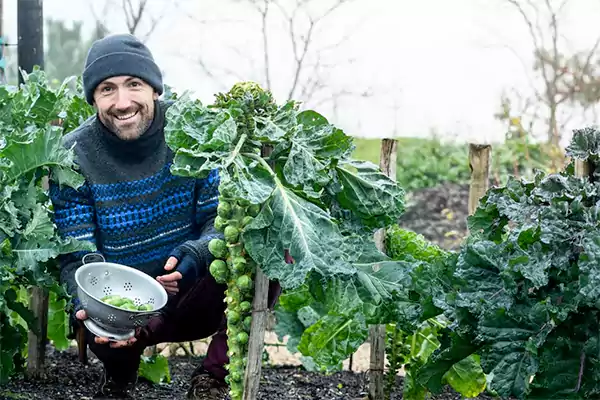
Now that I have enlightened you with the most workable care guide for the Brussels sprout plant, it is time to understand the ideal time to harvest the vegetable.
- The best indication that the species is ready to harvest is when it is about 1 inch in diameter. I personally prefer waiting till the frost temperature if possible.
- Brussels harvested during the colder season are generally sweeter than the regular ones. One of the primary reasons that the store-bought ones are bitter is that they follow the all-at-once harvesting technique.
- The sprouts always mature from the bottom of the stalk to the top, which is also the way they should be harvested. I always start by picking the larger sprouts, as these can also be snapped off the stalk simply by hand.
- For thicker stalks, prefer using pruning shears to avoid causing any damage to the stem. If you feel that the upper sprouts need time to mature, wait for some time and allow them to reach the ideal growth point.
Continue harvesting the stalk upwards, and you will enjoy a steady supply throughout the cool season.
Do You Know?
How long do Brussel Sprouts last in the fridge?
Brussels Sprouts last in the fridge for about 1 week, if kept loose, but if you keep the vegetable along with the stalk. It may last up to 2 weeks or more!
Brussels Sprouts Vs Cabbage – What’s the Difference?

I think now is the time for a real confession! Don’t be amazed when I say that I honestly planned to grow Cabbage, but accidentally ended up growing Brussels sprouts because of their similarity.
Both varieties belong to the same plant species, but they differ in size, taste, and most importantly, in terms of growth habit. I came across many Reddit users who are facing the same issue and are mistaking Brussels sprouts for mini Cabbages.
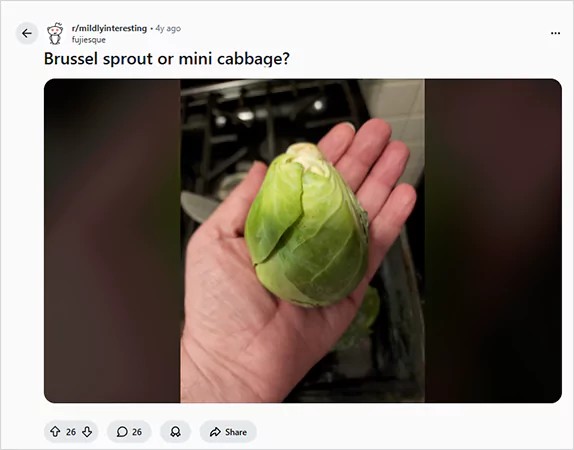
Here is a quick comparison to tell them apart easily!
| Features | Brussels Sprout Plant | Cabbage |
| Appearance | Small, round, and tightly packed buds. | Tight, dense layers of tender leaves. |
| Growth Habit | Grows in clusters on tall stalks. | Grows as a single head, close to the ground. |
| Taste | Bitter, nutty, and earthy in taste. | Mild with a sweeter taste. |
| Raw Usage | Cannot be eastern raw due to their bitter taste. | Mostly used raw in salads to add a crunchy texture. |
| Nutritional Benefits | High in vitamins A, C, K, and folate. | High in vitamin K and fiber. |
If I speak in terms of preference, many garden enthusiasts prefer growing cabbage over Brussels because of its low-maintenance nature and shorter growing season.
Types of Brussels Sprouts Plant
During my journey of exploring more about this winter season crop, I came across some unique cultivars of the species. I have mentioned a few of them in the table below for your ease.
| Cultivar Name | Image | Description |
| Jade Cross | 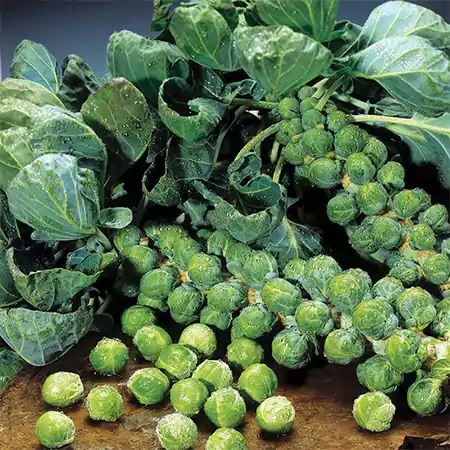 | This is a hybrid Brussels Sprouts plant known for its compact and high-yielding plants. |
| Long Island Improved |  | This is a classic variety of the Brussels plant, widely appreciated for its rich and nutty flavor. |
| Oliver |  | Oliver is a fast-maturing Brussels sprout cultivar, making it an ideal choice for gardeners starting late. |
| Falstaff | 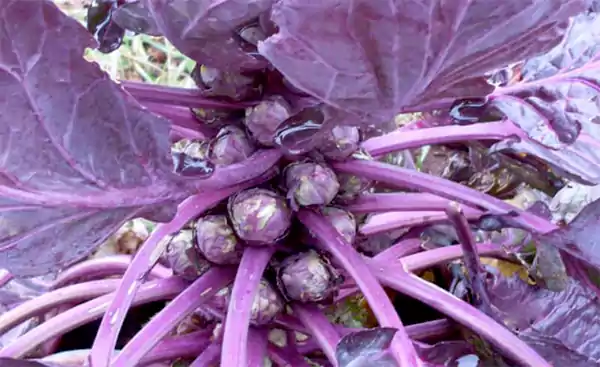 | The Falstaff Brussels is a reddish-purple cultivar mostly grown as an ornamental vegetable. |
Moving further, if you are also planning to add this botanical marvel to your garden, it is ideal to understand the common pests and diseases that might affect the overall growth of the vegetable.
Common Pests and Diseases
Like other plant species, the Brussels sprout plant is also susceptible to many pests and diseases. Some of the most common ones that I know about are mentioned below.
Aphids
These are small bugs, green, or black in color, often present on the underside of the leaves. They tend to leave a sticky residue called “honeydew” that can cause fungal infection on the leaves.
Use insecticidal soaps or best essential oils for plants that help in fighting these pests and while boosting the overall health of the plant. Start by spraying a strong jet of water to remove weak insects instantly.
Cabbage Loopers
Loopers are like tiny caterpillars that create unusual holes on the surface of the leaves as they feed on them. These spread rapidly, causing significant damage to the entire stalk.
Regularly inspect the plant and carefully remove them by hand. Isolate the plant and use insecticidal sprays to prevent the spread of Loopers.
While Mold
This is a fungal disease caused by a white cottony insect, which generally feeds on the leaves or the stem of the plant. It tends to suck out all the nutrition from the species, causing wilting leaves, stunted growth, and dead plants.
Ensure that the plants are properly spaced to improve air circulation. I prefer using high-quality fungicides at regular intervals to avoid such issues.
Many other insects, like cabbage maggots, stink bugs, and flea beetles, can affect the genus. Furthermore, my personal suggestion would be to cover the Brussels sprout plant row with a thin fabric, especially during its initial growing stages of the genus.
Common Issues Faced by Plant Lovers and My Personal Take on Them
While I was casually browsing different community forums, I realized that Reddit is full of queries about Brussels, and I discovered some that I had in common.
User Issue 1
FanEffective9521 had a healthy, growing Brussels Sprout plant, but within a week, the leaves of the plant had holes in them as if they had been eaten by something.
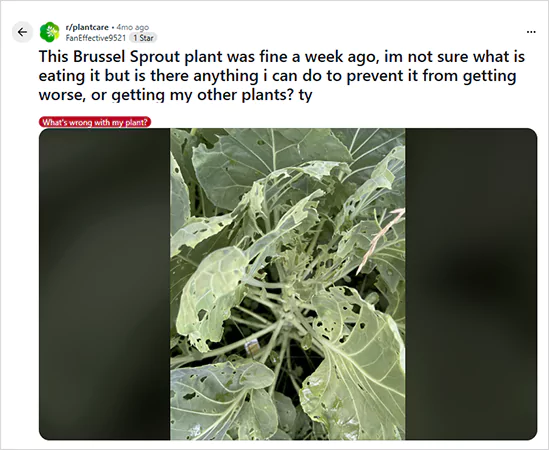
What Worked For Me
I also faced a similar issue when I was growing my first stock of Brussels. This generally happens when the plant is affected by Cabbage Loopers. You simply need to isolate the species, spray a strong insecticide to kill the leaf-eating insect, and trim off any damaged stems to avoid its spread.
User Issue 2
This was literally me when I was going to buy Brussels seeds. Just like Dancing Dorito thought that this plant could be grown as a houseplant, I was also excited to bring the genus to my balcony garden.

What Worked For Me
When I came across this query, it instantly took me back to the time when I had just started growing this species. I always prefer sowing the seeds indoors, and while I was doing so, I was living in the bubble of growing this vegetable in my balcony garden.
Little did I know the space and care it needed to flourish. I would still recommend sowing the seeds indoors, but transplant them outdoors in a big lawn once you see the seedlings!
Conclusion
Growing Brussel sprouts has given me so much joy because the journey from sowing the seeds to harvesting the final product has been so rewarding. What amazes me is the fact that, though the vegetable is small, it is packed with so much nutrition.
By now, I have learned that the only way to grow healthy Brussels Sprouts is to be patient. Simply provide the crop with its ideal growing conditions, and it will grow into a luxuriant crop.
What is the best month to plant Brussels Sprouts?
The best months to plant Brussels Sprouts are May and June for an autumn and winter harvest. Brussels Sprouts become slightly sweeter if they are exposed to frost temperatures.
Do Brussels Sprouts come back every year?
No, Brussels Sprouts do not come back every year. This cool-season vegetable is often seen as an annual species and demands replanting every year for a continuous harvest.
How long does it take Brussels Sprouts to produce?
It takes around 80–120 days for a Brussel Sprouts to mature, though the exact time varies and mostly depends on the growing conditions provided to the plant.
How do I trim Brussel Sprouts?
To trim Brussels Sprouts, start by removing the yellow/dead layers of the vegetable. Then chop off the hard stem at the base and start by cutting the sprout lengthwise or as you need it.
- Brussels Sprout – ScienceDirect
- Growing Brussels sprouts in home gardens – University of Minnesota Research Paper
- Brussels sprouts – Britannica


